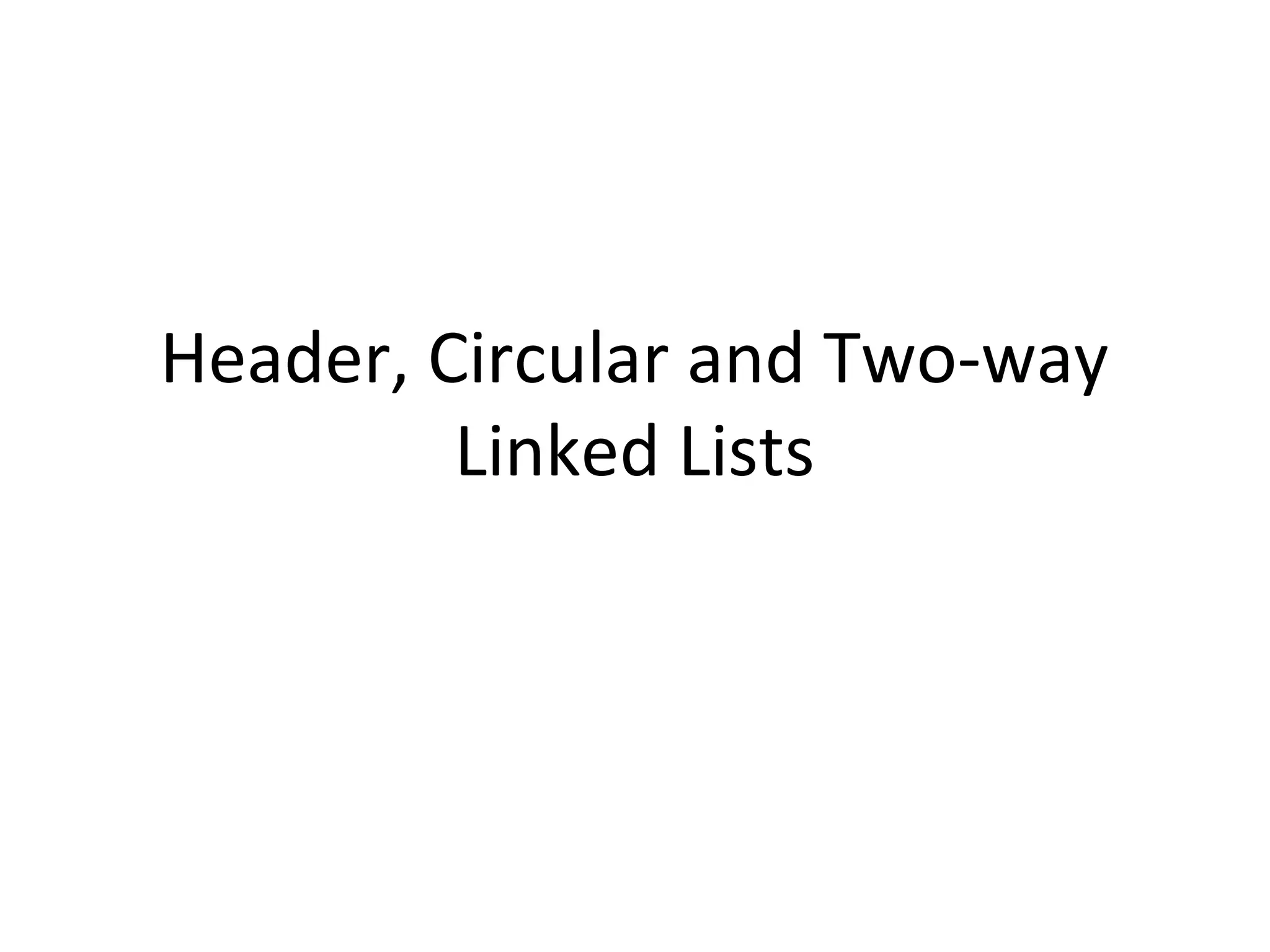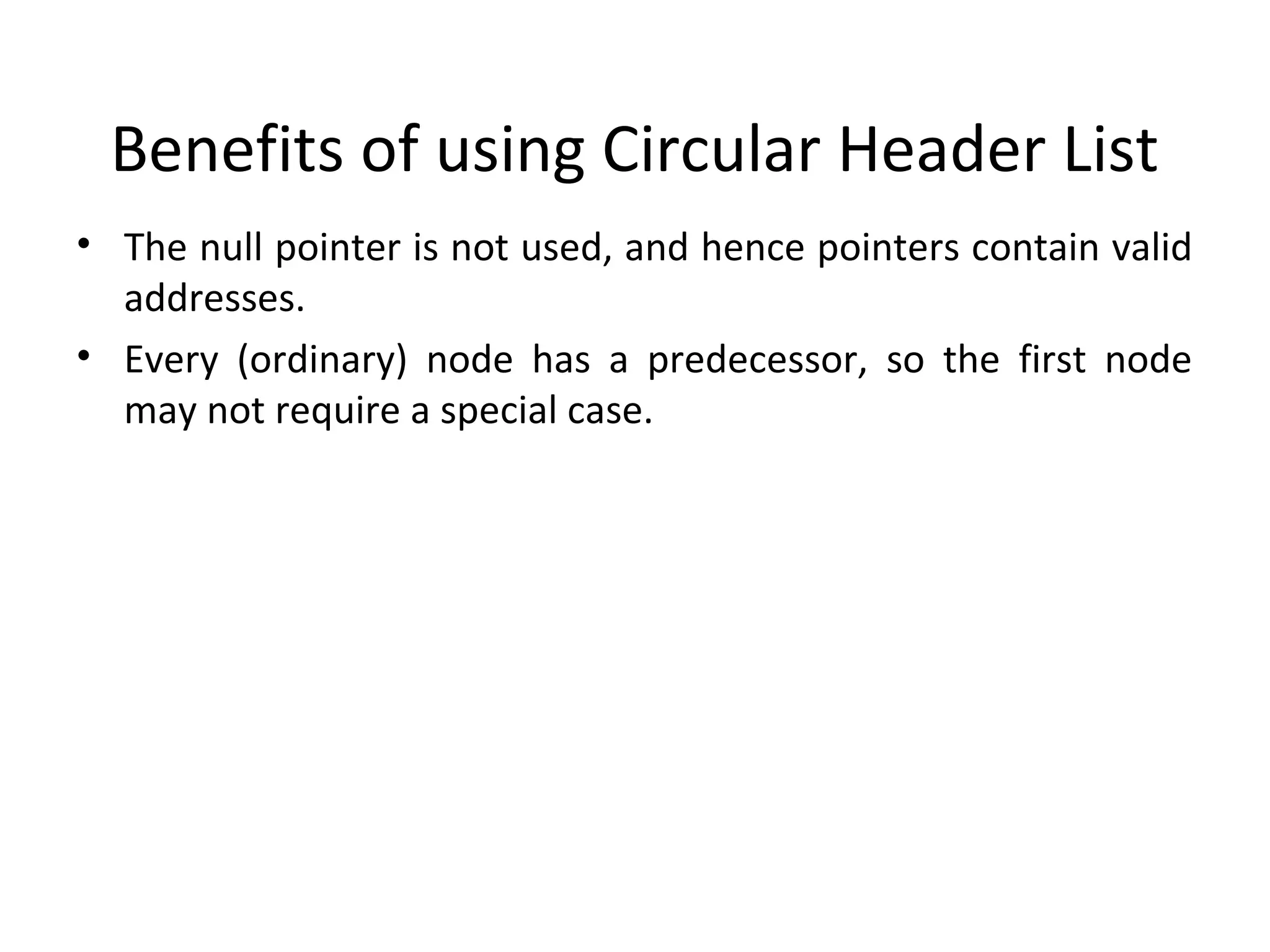This document discusses different types of linked lists including header linked lists, circular header linked lists, grounded header linked lists, two-way linked lists, and provides algorithms for traversing, searching, inserting, and deleting nodes from circular header and two-way linked lists. Header linked lists contain a special header node and can be circular or grounded. Circular header linked lists have the last node point to the header node, while grounded lists have the last node point to null. Two-way lists contain forward and backward pointers to traverse in both directions. Algorithms for traversing, searching, and modifying nodes in circular header and two-way lists are presented.



![Circular Header Linked List • A circular header linked list is a header list where the last node points back to the header node. • START always points to the header node. • LINK[START] = NULL means grounded header list is empty. • LINK[START] = START indicates that a circular header list is empty. Header Node Figure: Circular Header Link List Start](https://image.slidesharecdn.com/112666headercircularandtwo-waylinkedlists1-140926154559-phpapp01/75/header-circular-and-two-way-linked-lists-4-2048.jpg)

![Traversing a Circular Header List Let LIST be a circular header list in memory. This algorithm traverses list, applying an operation PROCESS to each element of LIST. The variable PTR points to the node currently being processed. 1. Set PTR := LINK[START]. [Initializes pointer PTR.] 2. Repeat Steps 3 and 4 while PTR != START. 3. Apply PROCESS to INFO[PTR]. 4. Set PTR := LINK[PTR]. [PTR now points to the next node.] [End of Step 2 loop.] 5. Exit.](https://image.slidesharecdn.com/112666headercircularandtwo-waylinkedlists1-140926154559-phpapp01/75/header-circular-and-two-way-linked-lists-6-2048.jpg)
![Searching in circular header list SRCHHL(INFO,LINK,START,ITEM,LOC) 1 Set PTR=LINK[START] 2 Repeat while INFO[PTR]!=ITEM and PTR!=START Set PTR=LINK[PTR] 3 if INFO[PTR]=ITEM, then Set LOC=PTR Else Set LOC=NULL 4 EXIT](https://image.slidesharecdn.com/112666headercircularandtwo-waylinkedlists1-140926154559-phpapp01/75/header-circular-and-two-way-linked-lists-7-2048.jpg)



![Inserting • INST(INFO, FORW, BACK, START, LOCA, LOCB, ITEM) 1. Set NEW := AVAIL, AVAIL=FORW[AVAIL]. [Allocate memory to the new node.] 2. 3. INFO[NEW] := ITEM. 4. Set FORW[LOCA] := NEW, FORW[NEW] := LOCB, BACK[LOCB] := NEW, BACK[NEW] := LOCA. 5. Exit.](https://image.slidesharecdn.com/112666headercircularandtwo-waylinkedlists1-140926154559-phpapp01/75/header-circular-and-two-way-linked-lists-11-2048.jpg)
![Deletion DEL(INFO, FORW, BACK, START, LOC) 1. Set FORW[BACK[LOC]] := FORW[LOC], and BACK[FORW[LOC]] := BACK[LOC]. 2. Free memory. FREE[LOC]. 3. Exit.](https://image.slidesharecdn.com/112666headercircularandtwo-waylinkedlists1-140926154559-phpapp01/75/header-circular-and-two-way-linked-lists-12-2048.jpg)